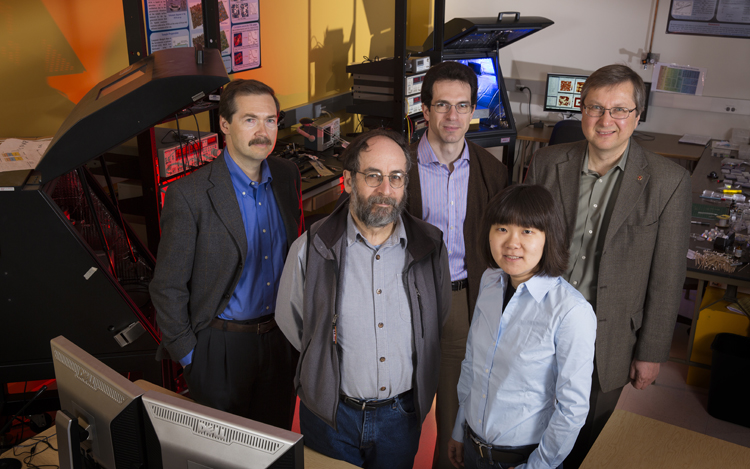
UNL will lead a new $7.125 million research collaboration involving six universities and an industry consortium to develop a new generation of electronic devices.
Semiconductor Research Corp. and the National Institute of Standards and Technology awarded a UNL physics team a five-year contract to lead a new Center for NanoFerroic Devices as part of the Nanoelectronics Research Initiative.
“Our faculty’s leadership of this collaborative research endeavor sponsored by a leading research consortium and the federal government is the latest recognition of UNL’s strength in nanotechnology and materials science,” said Chancellor Harvey Perlman.
The grant will be celebrated at 11 a.m. today (May 1) in the Van Brunt Visitors Center. The event is free and open to faculty, staff and students.
The center will harness the significant advances UNL and its Materials Research Science and Engineering Center have made in exploring nanomaterials with unique properties that may prove the key to surpassing the limitations of current technology, said UNL physicist Evgeny Tsymbal, who co-directs the new center with UNL physicist Peter Dowben. The National Science Foundation funds UNL’s MRSEC.
“It’s extremely important that we have MRSEC at the University of Nebraska-Lincoln because the new center is a natural continuation of the research that we’ve been doing,” said Tsymbal, director of the MRSEC. “Now we’re rising to a new level.”
This joint research will help transform basic university discoveries and knowledge into actual devices, in collaboration with industry. UNL is partnering with researchers at the University of California, Irvine; University of Wisconsin-Madison; University at Buffalo, SUNY; University of Delaware; and Oakland University.
Advances in silicon-based technology have made electronics ever smaller, faster and less expensive. But industry experts believe this technology will reach its limit within the next decade. That’s because today’s electronics use an electric charge to store and process information. Charges leak energy, generating heat and limiting the number of transistors that can be packed onto a chip. They also use energy, reducing battery life.
The new center will pursue three promising alternatives. Each takes advantage of unique, nano-scale properties that require much less energy, which would enable more compact and powerful devices.
In one initiative, UNL physicist Alexei Gruverman will lead a team based on his and Tsymbal’s work focused on nano-thin ferroelectric oxide, a material with both positive and negative polarization directions that can be reversed by switching voltage, which doesn’t generate heat. That duality is important because the polarization direction can be read like a binary code to store information. Gruverman and colleagues have shown that reversing the polarization changes the level of resistance as electrons pass between electrodes. Measuring that resistance would allow the device to read the polarization direction, and thus, the information it contains.
A second initiative relies on UNL physicist Christian Binek’s work with spintronics, which manipulates electron spin, in addition to charge, to store information. Traditional magnetic memory devices use a current to generate a magnetic field and change the magnetic direction, which is the binary method of storing information. Binek’s team discovered how to switch magnetization using voltage instead. The magic ingredient is chromia, the oxide form of chromium, which can be magnetized with voltage. Bringing a nano-thin film of chromia into contact with a ferromagnetic material and applying voltage switches the material’s magnetization direction.
The center’s third initiative, led by Ilya Krivorotov at the University of California, Irvine, carries information not just by switching the spin direction, but also by generating spin waves. Much like a sound wave carries information through time and space, a spin-wave device would be able to interpret information carried on a spin wave, which can also be generated using low-energy voltage.
All of these methods have the potential to go beyond today’s semiconducting systems, which would greatly expand computing potential, Tsymbal said. But he emphasized the need for collaboration among researchers and with industry to take these fundamental principles out of the laboratory and into specific devices.
“This university-industry consortium partnership brings together critical funding and expertise to transform the basic research discoveries at universities into a new generation of innovative devices to benefit society,” said Prem Paul, vice chancellor for research and economic development.
UNL physicists Kirill Belashchenko and Xia Hong also are members of the new center.
Industry partners involved in the projects include IBM, Intel, Micron Technology, Texas Instruments and GlobalFoundries. Semiconductor Research Corp. is the world's leading university-research consortium for semiconductors and related technologies. The Nanoelectronics Research Initiative and the collaboration with the National Institute of Standards and Technology are managed by the Nanoelectronics Research Corp., a special purpose subsidiary of SRC.
— Gillian Klucas, Research and Economic Development